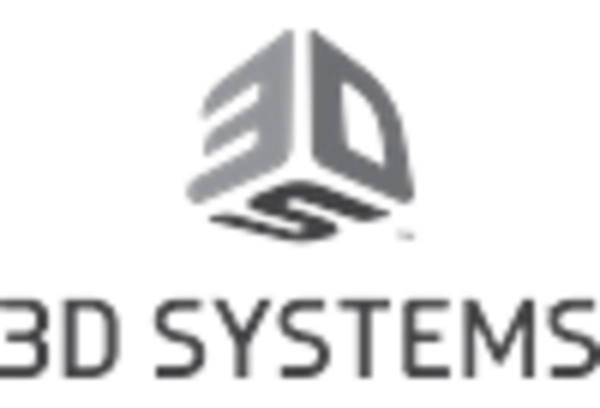The anatomical modelling market is currently characterized by a dynamic competitive landscape, driven by technological advancements and increasing demand for personalized healthcare solutions. Key players such as 3D Systems (US), Stratasys (US), and Materialise (BE) are at the forefront, leveraging innovation and strategic partnerships to enhance their market positions. 3D Systems (US) focuses on integrating advanced 3D printing technologies to produce highly accurate anatomical models, while Stratasys (US) emphasizes its commitment to developing materials that improve the fidelity of medical simulations. Materialise (BE) has carved a niche by offering software solutions that streamline the design and production of anatomical models, thereby enhancing operational efficiency across the sector. Collectively, these strategies foster a competitive environment that prioritizes technological innovation and customer-centric solutions.
In terms of business tactics, companies are increasingly localizing manufacturing to reduce lead times and optimize supply chains. This approach appears to be particularly relevant in the GCC region, where logistical challenges can impact delivery schedules. The market structure is moderately fragmented, with several players vying for market share, yet the influence of major companies remains substantial. Their ability to innovate and adapt to local market needs is likely to shape the competitive dynamics moving forward.
In October 2025, 3D Systems (US) announced a partnership with a leading healthcare provider to develop customized anatomical models for surgical planning. This collaboration is expected to enhance surgical outcomes by providing surgeons with precise, patient-specific models, thereby reinforcing 3D Systems' position as a leader in the anatomical modelling space. The strategic importance of this partnership lies in its potential to drive adoption of 3D printing technologies in clinical settings, ultimately improving patient care.
In September 2025, Stratasys (US) launched a new line of biocompatible materials specifically designed for anatomical modelling. This innovation is anticipated to expand the company's product offerings and cater to the growing demand for high-quality, safe materials in medical applications. The introduction of these materials could significantly enhance the quality of anatomical models, thereby attracting more healthcare providers to adopt Stratasys' solutions.
In August 2025, Materialise (BE) unveiled an upgraded version of its software platform, which integrates artificial intelligence to optimize the design process for anatomical models. This development is likely to streamline workflows for medical professionals, allowing for quicker turnaround times and improved accuracy in model production. The strategic significance of this upgrade lies in its potential to position Materialise as a frontrunner in the digital transformation of the anatomical modelling market.
As of November 2025, current trends in the anatomical modelling market include a strong emphasis on digitalization, sustainability, and the integration of AI technologies. Strategic alliances among key players are increasingly shaping the competitive landscape, fostering innovation and enhancing product offerings. Looking ahead, it appears that competitive differentiation will evolve from traditional price-based competition to a focus on technological innovation, supply chain reliability, and the ability to deliver customized solutions. This shift may redefine market dynamics, compelling companies to invest in R&D and collaborative ventures to maintain their competitive edge.

















Leave a Comment